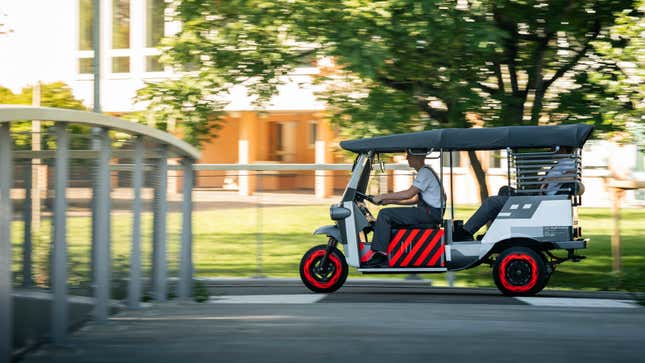Electric vehicles are pretty great at cutting down your environmental impact. But there’s no denying that as electric cars age, their range and battery life begins to drop. And with the ecological message EVs are championing, trashing these batteries isn’s an option. So Audi has begun investigating uses for its old power packs, including fitting them to some of the slickest rickshaws out there.
A rickshaw is a three-wheeled vehicle that’s sort of a cross between a moped and a van. They’re synonymous with places like India and Thailand, where they’re also called Tuk Tuks in reference to the sound of their two-stroke engine.
Now, Audi is hoping to revolutionize the rickshaw by swapping that two-stroke motor for an electric power unit and some old batteries.
To do this, the firm has partnered with German–Indian start-up Nunam to create three prototype electric rickshaws. The rickshaws all draw their power from old E-Tron batteries taken out of Audi’s fleet of test vehicles.

Each of the electrically-powered rickshaws is fitted with an electric motor in place of its gas-powered unit. They also have specially-designed flooring to accommodate the old E-Tron batteries and feature extensive splash-proofing.
By building rickshaws that can run on the used E-Tron power packs, Nunam and Audi hope to uncover ways to use old batteries as “second-life power storage systems,” which can extend the lives of the components and use the resources more efficiently.
“The old batteries are still extremely powerful,” said Nunam cofounder Prodip Chatterjee in a release.
“When used appropriately, second-life batteries can have a huge impact, helping people in challenging life situations earn an income and gain economic independence – everything in a sustainable way.”

The battery-powered rickshaws will first be put to the test on the roads of India in 2023. There, they will be used by a non-profit organization that will work with local women to transport goods to market for sale. As part of the program, Numan will also investigate installing solar panels at businesses to provide a clean source of energy to recharge the batteries.
What’s more, after the battery packs have run their course as rickshaw power units, Audi says they can be further utilized as a means of powering stationary appliances, such as LED lighting. This is similar to what BMW has done with its old car batteries, using them to power Coldplay’s recent stadium tour.
Isn’t all of this very neat! Now, excuse me while I work on a pitch for Audi to let me take one of these cute little trikes on the infamous Rickshaw Run.